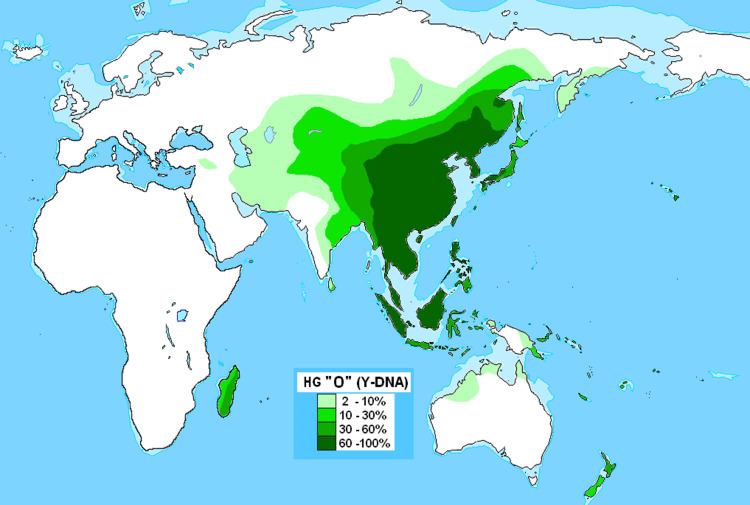Defining mutations M175, P186, P191, P196 | Ancestor NO | |
 | ||
Possible time of origin 28,000-39,000 years BP (Scheinfeldt 2006) Descendants O-MSY2.2, O-M268, O-M122 | ||
Haplogroup O-M175 is a human Y-chromosome DNA haplogroup. It is primarily found among populations in Southeast Asia and East Asia. It also is found among some populations of South Asia, Central Asia, Oceania, Madagascar, and the Comoros. The clade descends from the haplogroup NO.
Contents
Origins
Haplogroup O-M175 is a descendant haplogroup of Haplogroup NO-M214, and first appeared according to different theories, either in Southeast Asia (see Rootsi 2006, TMC & ?, Shi 2005, and Bradshaw & ?) or East Asia (see ISOGG 2012) between 28,000 and 41,000 years before present according to Scheinfeldt 2006 or between 23,000 and 32,000 years before present according to Yan et al. 2013.
Haplogroup O-M175 is one of NO-M214's two branches. The other is Haplogroup N, which is common throughout North Eurasia.
Distribution
This haplogroup appears in 80-90% of most of populations in East Asia and Southeast Asia, and it is almost exclusive to that region: M175 is almost nonexistent in Western Siberia, Western Asia, Europe, most of Africa, and the Americas, where its presence may be the result of recent migrations. Certain subclades of Haplogroup O-M175 do achieve significant frequencies among some populations of South Asia, Central Asia, and Oceania. Haplogroup O-M50 and a single instance of O-MSY2.2(xM50) have been found in Bantu-speaking populations of the Comoros, and both O-M50 and O-M95(xM88) occur commonly among the Malagasy people of Madagascar.
Among the sub-branches of haplogroup O-M175 are O-MSY2.2, O-M268, and O-M122.
Paragroup O-M175
Paragroup O-M175 lineages, which belong to Haplogroup O-M175 but do not display any of the later mutations that define the major subclades O-MSY2.2, O-M268, and O-M122, can be detected at a low frequency among some modern populations of Central Asia and East Asia. A broad survey of Y-chromosome variation among populations of central Eurasia found haplogroup O-M175(xM119,M95,M122) in a significant minority of Koreans (Wells 2001). However, nearly all of these Korean O-M175(xM119,M95,M122) Y-chromosomes may belong to Haplogroup O-M176, and later studies do not support the finding of Paragroup O-M175(Xue 2005, Kim 2011). O-M175(xM119,M95,M122) Y-chromosomes that have been found among these populations might therefore belong to Haplogroup O-MSY2.2*(xM119), Haplogroup O-M268*(xM95,M176), or Haplogroup O-M176.
O-F75
O1-MSY2.2 and O2-M268 share a common ancestor, O-F75, approximately 23,400 [95% CI 21,600 to 25,300] YBP.[1]. O-F75, in turn, coalesces to a common ancestor with O3-M122 approximately 24,700 [95% CI 23,000 to 26,500] YBP. Thus, O-F75 existed as a single haplogroup parallel to O3-M122 for a duration of approximately 1,300 years (or anywhere from 0 to 4,900 years considering the 95% CIs and assuming that the phylogeny is correct) before breaking up into its two extant descendant haplogroups, O1-MSY2.2 and O2-M268.
O-MSY2.2
O-M268
O-M122
Found frequently among populations of East Asia, Southeast Asia, and culturally Austronesian regions of Oceania, with a moderate distribution in Central Asia (Shi 2005).
Languages families and genes
The following is a phylogenetic tree of language families and their corresponding SNP markers, or haplogroups, sourced mainly from Edmondson 2007 and Shi 2005. This has been called the "Father Tongue Hypothesis" by George van Driem (vanDriem 2011). It does not appear to account for O-M176, which is found among Japanese, Korean, and Manchurian males.
Phylogenetic history
Prior to 2002, there were in academic literature at least seven naming systems for the Y-Chromosome Phylogenetic tree. This led to considerable confusion. In 2002, the major research groups came together and formed the Y-Chromosome Consortium (YCC). They published a joint paper that created a single new tree that all agreed to use. Later, a group of citizen scientists with an interest in population genetics and genetic genealogy formed a working group to create an amateur tree aiming at being above all timely. The table below brings together all of these works at the point of the landmark 2002 YCC Tree. This allows a researcher reviewing older published literature to quickly move between nomenclatures.
Original Research Publications
The following research teams per their publications were represented in the creation of the YCC Tree.
Phylogenetic trees
This phylogenetic tree of haplogroup O subclades is based on the YCC 2008 tree (Karafet 2008) and subsequent published research.
